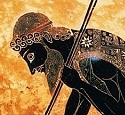|
MrNemo posted:Roman hipsters wore trousers and grew bushy moustaches. At least the later Western Imperial Romans did. I'm pretty sure those were called "Germans" not hipsters.
|
|
|
|

|
| # ? May 15, 2024 02:47 |
|
Arglebargle III posted:I'm pretty sure those were called "Germans" not hipsters. Well that was the thing, dressing like a filthy German barbarian to be cool.
|
|
|
|
SlothfulCobra posted:How comfortable was shaving back in Roman days? I think they used straight razors and olive oil, you can make your own judgement from there.
|
|
|
SlothfulCobra posted:How comfortable was shaving back in Roman days? Most of them (including Caesar) plucked their hair.
|
|
|
|
|
Bitter Mushroom posted:The chariot game is Qvadriga. It's pretty fun, although each of the colours are sponsored by a different political faction which seems ahistorical This is on steam, by the way. http://store.steampowered.com/app/297760/
|
|
|
|
Was discussing the violent sport episodes with a friend, and she ended up going off to translate them. They're both from the same bit of Pausanias, as it happens. If you'd like to read about Creugas, Damoxenos and Arrachion direct from the source, it's over there.
|
|
|
|
Alhazred posted:Most of them (including Caesar) plucked their hair. The last time I plucked my facial hair was when I was 15 and it looked less like stubble and more like a few scraggly pubes.
|
|
|
|
Fun thing playing around with the ORBIS map, even with the uneven shape of the Roman Empire, nothing was really further than about a months travel from Rome at fastest speed, or 1.5-2 months at a slower speed. I wonder if there is a way to conjecture the expanse of land that is within 1.5-2 months of travel of Rome and how that compares to what Rome actually conquered. Another observation was that the furthest parts of the empire were about 2 months away from each other. The Mediterranean was a great highway. One of the slower parts to get to was Dacia. I wonder how much of them giving that up was simply Torpor fucked around with this message at 00:34 on Jul 8, 2014 |
|
|
|
Really though wouldn't the speed of traveling not have changed much until the 19th century and the introduction of the steam engine and rail travel? Up until that point the fastest one could travel is by horse, right? and horses haven't changed all that much in 2000 years. Even travelling by ship. If the fastest the Romans could travel by sea was 6 knots, until the age of sail in the 18th century when things really took off, I don't think they were going all that much faster. Further sure; better deep ocean ships were built but they weren't all that fast. I think right before the steam engine was introduced they weren't doing much more than 10-13 knots. ok 10-13 kts is twice as fast as 6 kts but it's not really all that fast!
|
|
|
|
SeaWolf posted:Really though wouldn't the speed of traveling not have changed much until the 19th century and the introduction of the steam engine and rail travel? No, horses became bred to be a lot stronger and in some cases faster over the millenia. And with improved roads, and better routing (eg take a more direct route that might not have existed 500 years previously; which was created by finally draining some swampland to allow for a reliable path). There were almost certainly many trips you might take in say 1500 that could have had at least day or two of travel shaved off compared to what you could do in 500 or 1000.
|
|
|
|
SeaWolf posted:
|
|
|
|
Travel across land in Europe probably slowed after the roman period as the road network decayed and brigands came around.
|
|
|
|
physeter posted:That's a good estimated sustained speed for a trireme, but a trireme was a warship, basically their version of a modern destroyer. There were smaller craft. 10 knots is a pretty good estimate for a bireme carrying no cargo, burst speed probably around 12. There were even smaller craft with only one or half bank of oars, probably used for carrying urgent mail and VIP passengers, these would go faster. Weather and wind cooperating, figure about 17 knots across the Middle Sea if you could afford it and were really in a hurry. I've always understood that triremes were the fastest classical ships, since they were the perfect balance between weight and rowing power. And their sustained speed was six knots, with a burst of up to about 10. Is there some material that I could read about these super-fast biremes and couriers?
|
|
|
|
I think it's important to note that the biremes/triremes/etc weren't only oar-propelled. The ancients weren't idiots when it came to the wind, and I strongly suspect that along routes with good prevailing winds sails would have been faster than oars. Certainly more sustainable for long-haul travel at the very least.
|
|
|
|
They weren't even primarily oar propelled, best as we know. The oars were for speed and maneuvers in combat. Traveling from point to point outside of battle was done by sail.
|
|
|
|
Cyrano4747 posted:I think it's important to note that the biremes/triremes/etc weren't only oar-propelled. The ancients weren't idiots when it came to the wind, and I strongly suspect that along routes with good prevailing winds sails would have been faster than oars. Certainly more sustainable for long-haul travel at the very least. Merchant ships would have been primarily wind-powered, as a crew of oarsmen would have been too expensive to maintain. The bi- and triremes (as far as I remember) were primarily naval ships, with the ranks of oars being useful for speed and maneuverability in battle (which was primarily about ramming enemy ships). If you were sailing across the Mediterranean, the ship would have looked a lot like this: 
|
|
|
|
Grand Fromage posted:They weren't even primarily oar propelled, best as we know. The oars were for speed and maneuvers in combat. Traveling from point to point outside of battle was done by sail. And which makes perfect sense. Wind is free energy, calories required by oarsmen are not.
|
|
|
|
Torpor posted:Travel across land in Europe probably slowed after the roman period as the road network decayed and brigands came around. Yeah but most of that was repaired or exceeded a good couple centuries before trains and cars came about.You were not traveling as slowly as the Romans did across Europe in say 1650 even though you still had pretty much just horses on land and ships at sea for your travel.
|
|
|
|
Kaal posted:I've always understood that triremes were the fastest classical ships, since they were the perfect balance between weight and rowing power. And their sustained speed was six knots, with a burst of up to about 10. Is there some material that I could read about these super-fast biremes and couriers? I'd also like to read about these rowed ships that were faster than triremes.
|
|
|
|
Hogge Wild posted:I'd also like to read about these rowed ships that were faster than triremes. Liburnians and Hemiolia were the fast corvettes of the era and were used where speed was more important than ramming weight (eg scouting, transporting VIP's) I don't know how much hard evidence you will be able to get about speeds without doing some experimental archeology and actually building a few. I vote you do, because it'd be cool.
|
|
|
|
Captain Postal posted:Liburnians and Hemiolia were the fast corvettes of the era and were used where speed was more important than ramming weight (eg scouting, transporting VIP's) IIRC someone got a grant and put together a trireme and train up a rowing team.
|
|
|
|
I think the Greek Navy has one. But the smaller, faster, less glamorous ones that actually formed the bulk of fleets from the Roman era onwards haven't been built for 1500 years
|
|
|
|
the JJ posted:IIRC someone got a grant and put together a trireme and train up a rowing team. It's the armor dilemma though. It's much easier to build an ancient ship using ancient means than it is to train a team of rowers muscles from youth to adulthood to be best for the task.
|
|
|
|
Captain Postal posted:I think the Greek Navy has one. But the smaller, faster, less glamorous ones that actually formed the bulk of fleets from the Roman era onwards haven't been built for 1500 years They do! It's the only commissioned rowing ship of its kind. I was reading the Wiki on it and they said that they made a mistake in building it as a precise scale copy of the old Greek triremes. It worked perfectly, but the problem was that modern rowers are bigger than classical rowers, making the rowing-deck a really tight squeeze. Kaal fucked around with this message at 09:24 on Jul 9, 2014 |
|
|
|
Kaal posted:They do! It's the only commissioned rowing ship of its kind. I was reading the Wiki on it and they said that they made a mistake in building it as a precise scale copy of the old Greek triremes. It worked perfectly, but the problem was that modern rowers are bigger than classical rowers, making the rowing-deck a really tight squeeze. To tie into what I mentioned just before your post, wasn't it mentioned in this very thread that even being bigger, modern rowers weren't meeting the performance of antiquity rowers, biometrics aside.
|
|
|
|
Nintendo Kid posted:Yeah but most of that was repaired or exceeded a good couple centuries before trains and cars came about.You were not traveling as slowly as the Romans did across Europe in say 1650 even though you still had pretty much just horses on land and ships at sea for your travel. Even then, people traveling by foot can cover a lot of ground. Evolutionary biologists have pointed out that humans are well adapted for walking long distances. Trying to make a horse walk a marathon would be considered animal cruelty. But a human in reasonable terrain, with water, can walk thirty miles a day, then get up the next day and walk another thirty miles. thrakkorzog fucked around with this message at 10:02 on Jul 9, 2014 |
|
|
|
By animal standards humans basically never get tired ever. We're like the Terminator of the animal kingdom. So you swapped horses. The Mongols had it figured out and every 25 miles along predetermined routes there'd be a station with fresh horses and riders. You could cover a lot of ground very quickly that way. My understanding is you can make a horse run a hundred miles in a day, but that horse is going to spend the next month resting if it doesn't just pass out and die at the end of the run.
|
|
|
|
What about dogs though. Dogs can run like a million miles a day and still want to play.
|
|
|
|
Arglebargle III posted:What about dogs though. Dogs can run like a million miles a day and still want to play. Even the top Iditarod dog sled racing teams can only run about 30 miles a day. A human in decent shape in a temperate climate could walk that distance in about 10 hours. Admittedly, it would be a long day, but it wouldn't exactly require a superhuman effort. thrakkorzog fucked around with this message at 10:47 on Jul 9, 2014 |
|
|
|
Dogs do have pretty good endurance by animal standards though. That's part of why they made good companions for prehistoric human hunters. Humans are better, however. Sweating is part of that, we don't overheat easily. A human can run a dog (or gazelle or whatever) down until it dies from heat exhaustion. As far as I'm aware there's no animal that can do the opposite.
|
|
|
|
thrakkorzog posted:Even the top Iditarod dog sled racing teams can only run about 30 miles a day. A human in decent shape could walk that in distance in about 10 hours. Admittedly, it would be a long day, but it wouldn't exactly require a superhuman effort. To add to that; keep in mind training. A top dog may outperform an average human, but a top dog won't ever outrace (long-distance) a top human. Though in the 22 miles/35 km, horses still have humans beat (http://en.wikipedia.org/wiki/Man_versus_Horse_Marathon), but as suggested it is likely that this will knock out the horses for several days if not weeks and humans can start again next day or after a day of rest. Namarrgon fucked around with this message at 10:43 on Jul 9, 2014 |
|
|
|
Plenty of animals that could run a human down and kill and eat it though. Those horse marathon times are about 20 minutes faster than human times. Not as big of a difference as you would expect from what sprinting vs. galloping would suggest that's for sure.
|
|
|
|
Another thing to keep in mind about galleys/triremes/whatever as warships is that sometimes the wind dies down on you and suddenly you're a sitting duck for anybody with a set of oars.
|
|
|
|
Festive Transvestite posted:Another thing to keep in mind about galleys/triremes/whatever as warships is that sometimes the wind dies down on you and suddenly you're a sitting duck for anybody with a set of oars. Having oars when your opponent didn't was a huge advantage. However, "if the enemy's in range, so are you" -- close enough to ram is close enough to be boarded. If the ship without oars also had siege weaponry, even better for them.
|
|
|
|
Arglebargle III posted:Plenty of animals that could run a human down and kill and eat it though. I think the bottomline of that whole conversation is, that if you manage to stay on a trail of an animal, you can chase it to death. You just stalk it until it drops from exhaustion. Works with deers et al. so I heard.
|
|
|
|
physeter posted:Killed in the attempt. Romans didn't usually award posthumous decorations. You had to do the deed and live. The corona muralis went to the first man over the enemy fortifications who also lived...so that meant you had be the very first guy over the wall and survive to the end the battle. Didn't happen alot. Naval crown was the same thing except with a hostile enemy ship so same story. Civic crown was you had to find one of your own men about to die on enemy ground, save his life by killing his attacker(s), and then hold that ground until battle's end. Oh and the guy you saved had to live too. So if you grabbed the guy and ran him back to your own lines, that wasn't stones enough. This is cool (and I realize im quoting page 2 or W/E, but sorry, want to share this story), I was googling and found the attached image below Now, in modern times we have marines who are attached to the navy but theyre marines. I find it hard to believe some sailor with a sword and no armor raced up the ladder along side a loving centurion bad rear end but maybe everyone just had balls back then. Including all of his sailor bros who were apparently going to square off against the legionaries. Also also, how the gently caress did they survive in the city until a second wave was launched? Jesus Can anybody describe what they mean by sailor here and if they were just treated like regular aux. troops or what? Were they trained as well as the roman legions? edit: imgur link for broke rear end forum attachmnts 
Drunk & Ugly fucked around with this message at 19:18 on Jul 9, 2014 |
|
|
|
Roman marines were basically just legionnaries put aboard ship, so I imagine they do mean a shiphand who hauled sails up and down or something. Does the footnote have a cite?
|
|
|
|
Sleep of Bronze posted:Does the footnote have a cite? Livy 26.48.5 ? whatever that is. Here's the page in google; just searched for "37" to find the ref http://books.google.co.uk/books?id=Nuex2PW7QR0C&lpg=PA77&dq=corona%20muralis&pg=PA77#v=onepage&q=corona%20muralis&f=false
|
|
|
|
Sleep of Bronze posted:Roman marines were basically just legionnaries put aboard ship, so I imagine they do mean a shiphand who hauled sails up and down or something. Does the footnote have a cite? itaque quamquam omnibus omnia deberet, praecipuum muralis coronae decus eius esse qui primus murum adscendisset; profiteretur qui se dignum eo duceret dono. duo professi sunt, Q. Trebellius, centurio legionis quartae, et Sex. Digitius, socius naualis Hard to say what the sailor's job was -- he's part of the crew of a ship provided by an allied city. Most likely a marine trained for that sort of thing, though.
|
|
|
|

|
| # ? May 15, 2024 02:47 |
|
Even then ... Kathryn Lomas, 1993 posted:Livy uses the term socius navalis indiscriminately, applying it to full-time marines, legionaries drafted into the fleet, marines serving on Carthaginian, Rhodian and Pergamene ships, and to the crews of the Roman fleet of 310 BC, a date when there were no allies serving in the Roman fleet.
|
|
|






























